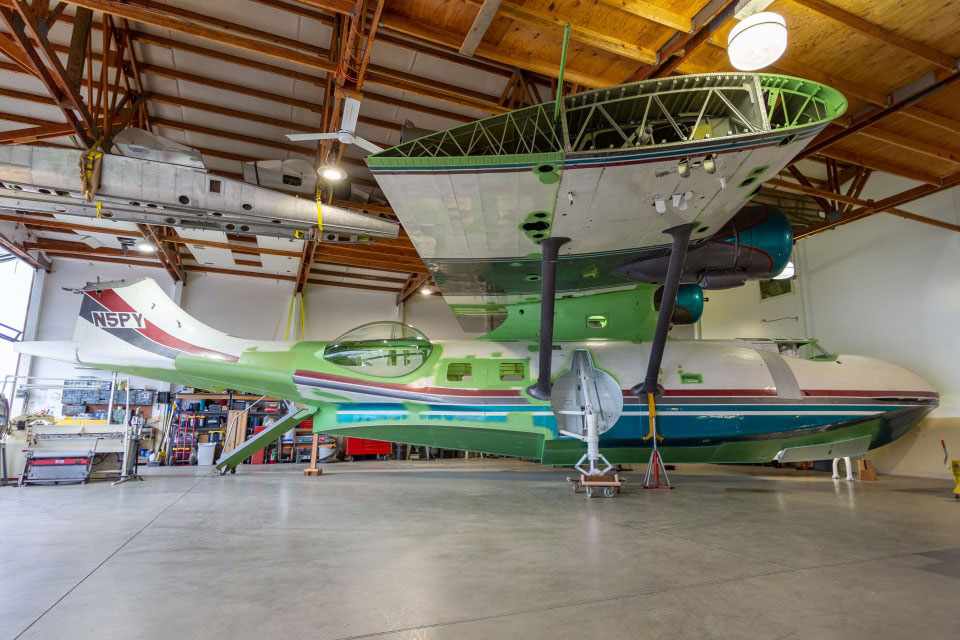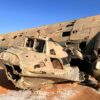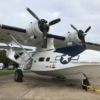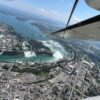There is no let-up in Catalina activity worldwide so without further ado, let’s go!….
The late Wilson ‘Connie’ Edwards was well known as a somewhat swashbuckling US warbird owner, one of the pilots that came over to Europe in the late-60s to fly Spitfires in the Battle of Britain film. He famously accepted payment in the form of Spanish ‘Buchon’ fighters and stored these for many years alongside a Spitfire, Mustang and an airworthy Grumman Albatross on his ranch airstrip at Big Springs in Texas. Over the years he also owned two Catalinas which he used extensively although his activity reduced as he grew older and after the car accident that claimed the loss of his son. After Connie passed away a few years back his massive collection of aircraft and parts was put up for sale. His PBY-6A Catalina N4NC was sold to Scott Glover of the Mid America Flight Museum at Mount Pleasant, Texas in September 2019 but more recently it was sold on to the Liberty Aviation Museum of Port Clinton, Ohio. It was formerly registered to that organisation on February 14th this year and was flown to its new base at the Erie-Ottawa International Airport from Mount Pleasant Regional Airport on March 29th. It arrived at its new home in the early-evening after a stopover at Cape Giradeau Regional Airport in Missouri en route. The crew consisted of Todd Mather, Scott Boyer and Doug Rozendaal. The Liberty Aviation Museum announced prior to its arrival in Ohio that the Catalina will be put on display for public viewing during opening hours and visitors will be able to view workers and volunteers maintaining, cleaning and restoring the new exhibit along with others throughout its interactive museum. After a thorough assessment, a series of upgrades and updates will take place over the coming months. ‘The PBY will be an amazing addition to our collection of flying aircraft’ said a museum spokesperson.
In the summer of 1986, Connie briefly visited the UK in N4NC to celebrate the 75th anniversary of US naval aviation after flying across the Atlantic. It was accompanied by former RCAF Canso A C-FOWE which at the time was owned by Robert Franks. Some readers may recall that upon arrival at Plymouth it waterlooped and sank after flaring and landing long, striking a substantial buoy which removed part of the flying boat’s port wing. Many years later, Connie acquired this aircraft too and it was re-registered to him as N222FT and painted in a garish colour scheme with the name Flyin Turtle. She remains active with her current owner PBY LLC of Wilmington. Following its trip to Hawaii described in Issue 94 of The Catalina News, she has appeared at various other events including a gathering of Grumman Avengers in Illinois in May last year, the Experimental Aircraft Association AirVenture event at Oshkosh, Wisconsin in July the same year and, in April this year, the Sun ‘n Fun Aerospace Expo event at Lakeland, Florida. It has recently been seen on a flying ranch near Ocala, Florida and may be based there part of the time as that is where the owner lives.
Frederick ‘Rick’ Peterson acquired the very last PBY-6A Catalina N9825Z to be built from the auctioned fleet of waterbombing company SLAFCO in October 1999. It remained at its former base at Moses Lake, Washington whilst Rick started a lengthy and detailed restoration to ‘stock’ condition. The project was far from complete when he passed away some months ago and ownership formerly passed to Susan E Peterson on March 22nd last year. It remains to be seen if restoration will continue or be sold on.
Another long-term project involves the one-time Canso A N5PY which for many years flew with four engines as the Bird Innovator. Acquired by Ron Ruble in May 2007 it was flown to Aurora, Oregon and a conversion to conventional twin-engined configuration commenced. This turned into an almost total rebuild with a great deal of re-skinning involved. The result to date is stunning. In recent years it has been offered for sale by various parties, most recently by local company Aerometal International who had taken on the work for the owner. Asking price for the uncompleted project is US$950,000. Their advertisement states that they are ‘thrilled to offer this unique project for sale at this time (and in this configuration, with arguably all the hard work accomplished). The aircraft can really be considered a blank canvas and any prospective buyer can expect to launch immediately into the completion stage of the project. Work of this scope and quality (on this kind of scale) is difficult or impossible to plan and prepare for. The truly comprehensive structural restoration accomplished must surely make this a unique opportunity. Whether your dream is to take a large flying boat around the world or simply to win ‘best-in-show’, this is an opportunity to make these goals attainable and tangible. The aircraft is offered for sale in Aurora, Oregon, our home base field – with the restoration facilities of Aerometal International less than a mile South along the Alpha taxiway at KUAO (Aurora State Airport).’.
In Spain, John Sterling’s PBY-6A Catalina N24VP remains at Ocaña nr Toledo although the long-term plan is to get it flying and across to the USA. John reports that Clive Edwards, well known for his work on Catalinas in the past, visited the Catalina to give an assessment on the viability of dismantling it and transporting it to the US by sea. Although this approach would be cheaper than flying it across, the plan is still to get it airworthy and to this end John is looking to obtain a pair of mid-time engines to replace those currently on the airframe.
I have mentioned the PBY-6A Catalina L-866 (RAF Instructional Airframe number 8466M) that is part of the RAF Museum Cosford collection before in this column. To re-cap, some years ago it was ‘temporarily’ relegated to outdoor display to make room for another exhibit. The museum always said that it would be moved back but this has never happened. The RAF Museum recently published two quite long lists of airframes that are either for disposal or where they are available for loan to other museums. Most of the aircraft are currently at Cosford although some others are either at Hendon or in store at Stafford. In the disposal category are aircraft that are either duplications of other examples in the RAFM collection, incomplete aircraft or ones that have limited relevance to the collection. The loan category includes the Catalina. This was donated to the RAF by the Royal Danish Air Force back in June 1972 and flown to the UK on May 30th, 1974 (with Catalina Society member Erik Thingbo on board as Flight Engineer). It was initially stored at RAF Colerne in Wiltshire then transported to Cosford in October 1975. Whilst part of the internal display there it was kept in very good condition, but this has been harder to achieve during the subsequent prolonged spell outdoors although the airframe still remains in generally good order. Inevitably, any museum disposals can be controversial and the appearance of the Catalina on the ‘loan list’ has raised eyebrows. But of course, the PBY-6A model does not have a direct relevance to the RAF which did not operate the type. In reply to a request for information, RAFM Curator Dr Peter Johnston said: ‘Unfortunately, I cannot comment on the process as in the interests of fairness we need to keep the progress confidential until both parties have agreed. We will announce in due course, but currently I cannot share any further information.’ It remains to be seen if any collection at home or abroad puts in a bid for the Catalina. Given its size, it will not be an easy job to transport it elsewhere even if another museum has the resources to take it on. The risk is that it will go somewhere else and remain outdoors or stay where it is at Cosford and deteriorate. Watch this space.
From time to time, Catalina spares and components come onto the market. Earlier this year, a set of wingtip floats were offered for sale after they had surfaced during a workshop clear-out in North Dakota. Their provenance is not known but the manufacturer’s plates clearly show they were made by Firestone for the Consolidated Vultee Aircraft Corporation, New Orleans Division so were most likely from a late-production PBY-5A or a PBY-6A. The Australian organisation HARS (Historical Aircraft Restoration Society have been offering a set of PBY-5A elevators for A$£3,000.
The National Museum of World War II Aviation carried out a fund-raising ‘Catalina pull’ on September 18th last year using the Canso A N427CV. This ‘Pulling for a Purpose’ event sponsored by Special Olympics Colorado attracted 20 teams of ten people each and was the first event of its kind to be held at Colorado Springs although similar plane-pulls with other aircraft types have been held at Denver International Airport and Rocky Mountain Metropolitan Airport, Broomfield. A staggering $50,000 was raised for Special Olympics Colorado which supports sports training and competitions for 15,000 people with intellectual disabilities in the state of Colorado. Some years ago, our own organisation carried out a sponsored Catalina pull down the Duxford runway and back using the PBY-5A N423RS which, at the time, was under care and maintenance with us whilst awaiting sale by its owner Greenpeace.
Work continues on PBY-5A Catalina N459CF at American Aero Services, New Smyrna Beach, Florida. The Catalina, owned by the Collings Foundation and well-known in Europe as the former PH-PBY based in the Netherlands, has recently had a bow turret grafted onto the forward hull and it looks very impressive…..
Last September 4th, the Rathmines Catalina Association (RCA) made the following announcement: ‘Today the RCA announced the relocation of the Catalina Our Girl and Rathmines memorabilia to the proposed Royal Australian Air Force (RAAF) Williamtown Aviation Heritage Centre near Newcastle, NSW. Since 2007, the RCA has worked towards a Heritage Centre at Rathmines to house its RAAF Base Rathmines memorabilia and Catalina aircraft. Unfortunately, that proposal did not have the support of Lake Macquarie Council. The RCA has been in discussions with the RAAF who have welcomed the inclusion of the Catalina in the new RAAF Williamtown Aviation Heritage Centre (where the RAAF already has its Fighter World museum). It is exciting that RAAF expertise will also be lent to establishing a tribute to RAAF Base Rathmines incorporating the significant collection of RCA memorabilia.’ The Association was disappointed at the local council’s decision not to support the proposal for a centre at Rathmines Park but the move to Williamtown is viewed as a great alternative. But given that RAAF base Rathmines and Lake Macquarie were significant places associated with RAAF Catalinas, the RCA’s initial disappointment is understandable. Meanwhile, volunteers continue to carry out their restoration work on Our Girl, formerly PBY-5A Catalina N7238Z, which the organisation rescued from an uncertain fate in Puerto Rico. The Catalina’s main components are currently still located in the Kilaben area about 30 miles south of Newcastle.
Readers are reminded that a full list of surviving Catalinas, airworthy and non-airworthy, is maintained on the website of The Catalina Society – use the ‘Survivors’ tab at www.catalina.org.uk
This article is a web version of that included in the 24-page Summer 2022 edition of The Catalina News magazine sent to all subscribing members of The Catalina Society.

PBY-6A N4NC after arrival at its new home at the Liberty Aviation Musuem – the crew consisted of, left to right, Todd Mather, Scott Boyer and Doug Rozendaal.
Liberty Aviation Museum

N222FT, once a RCAF Canso A, arrives at the Sun ‘n Fun event at Lakeland, Florida in April 2022 Aaron Haase




















